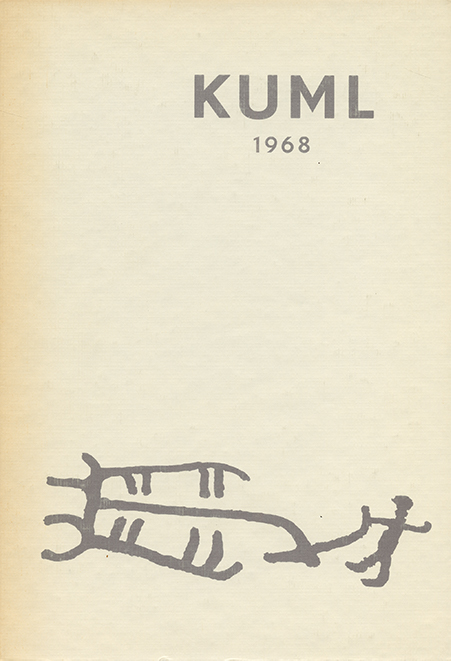Bronzehåndtag til et spejl fra Barbartemplet på Bahrain
DOI:
https://doi.org/10.7146/kuml.v19i19.105139Nøgleord:
Kulli, barbar, temple, tempel, bahrain, bronze mirror, bronze spejlResumé
A bronze mirror handle from the Barbar temple, Bahrain
A further link with the Kulli culture - south Baluchistan.
Among the copper or bronze objects recovered during the excavations at the temples of Barbar in the northern coast of Bahrain, is an interesting human figure described as "a little naked male figure, standing on a base which is curved at the foot and cast in one piece" [1]. (fig. 1). The figure holds his hands clasped at the breast like the Mesopotamian gods, and measures 11 cms. in length. It is compared with a copper figure from Chouchinak temple in Susa [2], which is dated to the middle of the 3rd millennium B.C.
Thanks to the courtesy of Dr. Geoffrey Bibby, I had an opportunity to examine this metal figure, among other objects from the Persian Gulf, in September 1967. At once, it struck me to compare with the handle of a copper mirror from Mehi, a Kulli culture site [3]. The handle of this mirror represents "a stylised female figure, with breasts and conventionalised arms akimbo, but with the head provided only by the reflection of the user of the mirror" [4] (fig. 2). The disc mirror was revetted, in this instance, into the curved slit at the neck. On this comparison, there is no doubt that the Barbar example is the human handle of a mirror, with the difference that the human figure is male and complete, and the curved slit being provided for fixing the mirror, below the feet. The comparison of the two objects at once indicates contacts between the two cultures. Evidences for such contacts between Kulli and the Gulf have already been indicated by the occurrence of the typical Kulli-type canisters, compartmented steatite vases with incised decorations, and the black buck or ibexes with curved, swept-back horns and the bull motif with elongated body at the sites of Umm an-Nar, and Hili, near Buraimi Oasis, in the Sheikhdom of Abu Dhabi [5].
Metallic mirrors with plain handles have been known from many sites of the Ancient East [6], but human figures used as mirror handles, although familiar in Egypt in the XVIII dynasty (dated from about 1570 B. C.) are said to be unknown in western Asia [7]. Thus the present handle from Barbar is only the second example known so far.
Barbar period has been dated to circa 2303-2108 [8], and thus this mirror handle would also be ascribed to this period. The Mehi example comes from a cemetery, which belongs to the upper phase at the site. This upper phase is said to be contemporary with the Harappan culture [9]. Therefore, on comparative evidence, the date of B. C. 2303 appears to be quite in order. Further confirmation comes from the finding of Indus valley type seals, cubical chert weights etc. in the Persian Gulf excavations [10].
This mirror handle therefore provides yet another link between the Gulf and the S. Baluchistan cultures.
M. S. Nagaraja RaoDownloads
Publiceret
Citation/Eksport
Nummer
Sektion
Licens
Fra og med årgang 2022 er artikler udgivet i Kuml med en licens fra Creative Commons (CC BY-NC-SA 4.0).
Alle tidligere årgange af tidsskriftet er ikke udgivet med en licens fra Creative Commons.


